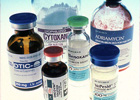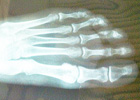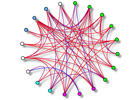 As UHN's monthly research newsletter, NRx reports on the full spectrum of leading research from UHN's five research institutes. Located in downtown Toronto, these institutes are the Princess Margaret (PM) Cancer Centre, the Toronto General Research Institute (TGRI), the Toronto Western Research Institute (TWRI), the Toronto Rehabilitation Institute (TRI) and the Techna Institute (Techna).
As UHN's monthly research newsletter, NRx reports on the full spectrum of leading research from UHN's five research institutes. Located in downtown Toronto, these institutes are the Princess Margaret (PM) Cancer Centre, the Toronto General Research Institute (TGRI), the Toronto Western Research Institute (TWRI), the Toronto Rehabilitation Institute (TRI) and the Techna Institute (Techna).
In this issue you can read about:
- How blood proteins can help to diagnose pancreatic cancer
- The hidden costs of chemotherapy drugs
- Insights into the control of a molecular channel
- How livers from live and deceased donors compare
- Genetic readouts of psoriatic arthritis
- A new way to study how proteins work together
We hope that you will find NRx informative. If you have feedback or questions, please contact www@uhnresearch.ca.
Christopher J. Paige, PhD, FCAHS
Vice President, Research
University Health Network

Smoking is a proven risk factor of pancreatic cancer. Long-term smokers are around twice as likely to develop the disease.
Pancreatic cancer has the highest mortality rate of all major cancers and the survival rate has remained low for over 30 years. This is the case because the most common type of pancreatic cancer—known as Pancreatic Ductal Adenocarcinoma (PDAC)—is often diagnosed at later stages in the disease, after it has spread to other parts of the body.
For a number of conditions, measuring levels of proteins in the blood—known as serum biomarkers—can enable physicians to confidently determine whether symptoms are the result of disease. For PDAC, the CA19.9 protein is the only approved biomarker; unfortunately, CA19.9 lacks the sensitivity and specificity required to identify patients with earlier stages of the disease.
A recent study, led by PM and TGRI Clinical Researcher Dr. Ivan Blasutig, addresses this issue by testing a diverse group of new and existing biomarkers for their ability to identify pancreatic cancer. Dr. Blasutig's team tested the biomarkers, alone and in combination, in blood samples from patients with early and late stages of the disease. The results showed that a combination of three biomarkers—CA19.9, CA125 and LAMC2—was more effective at detecting the disease than CA19.9 alone.
Dr. Blasutig adds, "Our biomarker combination was better at identifying early stages of the disease. Thus, these biomarkers may enable physicians to begin treating those patients who will benefit most."
This study was supported by The Early Detection Research Network through the National Cancer Institute, the Toronto General & Western Hospital Foundation and the Princess Margaret Cancer Foundation.
Validation of biomarkers that complement CA19.9 in detecting early pancreatic cancer. Chan A, Prassas I, Dimitromanolakis A, Brand R, Serra S, Diamandis EP, Blasutig IM. Clinical Cancer Research. 2014 September 19. [Pubmed abstract]

Currently, the cost and inconvenience of managing unwanted effects is not a consideration in the approval process for new anticancer drugs.
Treating cancer often involves trade-offs, as many anticancer drugs cause adverse effects such as fatigue and diarrhea, or even more severe and potentially fatal events like bleeding or blockages in major blood vessels. New anticancer drugs are rigorously tested in clinical trials before being approved; however, clinical trials can under-report the expected rate of adverse events because recruited patients tend to be healthier with fewer complications and because the timeframe of a clinical trial can miss toxicity that does not manifest until long after the treatment course.
PM Senior Scientist Dr. Ian Tannock and colleagues analyzed the results of 41 studies that investigated 19 new anticancer drugs to quantify the cost of adverse events associated with approved therapies. They found that new drugs with specific molecular targets resulted in fewer adverse events than existing treatments. Conversely, new drugs that did not have specific molecular targets had increased rates of adverse events that led to $140 more in hospital costs per patient, which adds to the already higher price of the new drugs themselves.
"These results suggest that the development of more personalized and targeted cancer therapies should be encouraged." concludes Dr. Tannock. "Furthermore, it is important to monitor and report adverse events after a drug moves into routine practice in order to identify delayed toxicities."
This work was supported by The Princess Margaret Cancer Foundation.
Risk of incremental toxicities and associated costs of new anticancer drugs: a meta-analysis. Niraula S, Amir E, Vera-Badillo F, Seruga B, Ocana A, Tannock IF. Journal of Clinical Oncology. 2014 Sep 29. [Pubmed abstract]

Potassium channels are specialized tunnels that control cell functions by enabling potassium ions to flow in and out across the cell membrane.
Calcium-activated potassium channels are proteins that are widely expressed on the surface of many cells types. One subtype, the KCa3.1 channel, is present on immune cells and cancer cells. Preclinical studies have shown that inhibiting KCa3.1 function reduces inflammation in experimental models of several diseases, including stroke, spinal cord injury, Alzheimer's disease and autoimmune disorders. Given the role of KCa3.1 in these diseases, it is important to understand how this channel is regulated.
A new article by TWRI Senior Scientist Dr. Lyanne Schlichter provides evidence that KCa3.1 function is inhibited by a signalling pathway that involves adenosine, cyclic AMP and cyclic AMP protein kinase (PKA). This is an important anti-inflammatory pathway that protects cells in the central nervous system, and elsewhere in the body, from injury.
Dr. Schlichter and her team used molecular biology and biochemistry techniques, as well as electrical and optical recordings, to study KCa3.1 function in microglia (immune cells that reside in the central nervous system). They discovered that the adenosine-PKA pathway inhibits KCa3.1 channel activity. This resulted in less calcium entry into the cells, an event that controls microglial activation. They verified the results by making a mutated version of the KCa3.1 channel that lacked the ability to interact with PKA. As expected, this modified channel was incapable of responding to the PKA signalling pathway.
Explains Dr. Schlichter; "Both PKA and the KCa3.1 channel are involved in a variety of human diseases. Although inhibiting KCa3.1 is beneficial in several disease models, its interaction with PKA was controversial until now. Our study shows that KCa3.1 is regulated by PKA, an interaction that might represent an important therapeutic target."
This work was supported by the Heart and Stroke Foundation and the Toronto General & Western Hospital Foundation.
PKA reduces the rat and human KCa3.1 current, CaM binding, and Ca2+ signaling, which requires Ser332/334 in the CaM-binding C terminus. Wong R, Schlichter LC. Journal of Neuroscience. 2014 Oct 1. [Pubmed abstract]

Ring graph showing numbers of Canadians in 2012 that had liver transplants (white), were on the waiting list (grey) and who died while waiting for a transplant (black) [Canadian Organ Replacement Register].
Hepatorenal syndrome (HRS) is a severe complication of end-stage liver disease that affects the kidneys. People with HRS require a liver transplant to prevent further degeneration of both vital organs. Traditionally, those in need of transplants are placed on a waiting list for available organs from deceased donors.
Given the organ shortage and the high mortality rate of people on the waiting list, using live donors for transplantation—in which a portion of the liver is donated—is an attractive option. To date, there have been few studies evaluating the efficacy of this approach in people with HRS.
In a study led by TGRI Affiliate Scientist Dr. Markus Selzner, outcomes were compared between HRS patients who received live donor liver transplants and those who received organ transplants from deceased donors. Dr. Selzner's team measured readouts of transplant success for up to five years after the surgery. They found that there were virtually no differences in liver function, kidney function or patient survival between the two groups. In fact, certain factors (eg, length of hospital stay) were improved in patients receiving tissue from live donors.
These results demonstrate that live donor liver transplants are an effective option for HRS patients. This is of particular value to people with moderate to severe HRS—this group moves higher up on the transplant waiting list, yet currently there is no guarantee that an organ will be made available before their disease worsens to the point when a transplant would no longer be beneficial.
This work was supported by the Toronto General & Western Hospital Foundation.
Living vs. deceased donor liver transplantation provides comparable recovery of renal function in patients with hepatorenal syndrome: a matched case-control study. Goldaracena N, Marquez M, Selzner N, Spetzler VN, Cattral MS, Greig PD, Lilly L, McGilvray ID, Levy GA, Ghanekar A, Renner EL, Grant DR, Selzner M. American Journal of Transplantation. 2014 Oct 2. [Pubmed abstract]

There is currently no widely accepted diagnostic test for psoriatic arthritis; rather, it is diagnosed using various methods, including x-rays (pictured above) and physical examinations.
Psoriasis is an immune-mediated condition that can lead to the appearance of inflamed, scaly patches of skin. People with this skin condition are at risk for developing a related condition called psoriatic arthritis (PsA), which is an inflammatory form of arthritis that also involves the insertion of tendons and ligaments into bone (enthesitis), swelling of a whole digit (dactylitis) and inflammatory spinal disease. Early diagnosis and treatment of PsA is essential because, if left untreated, it can lead to disability and permanent joint damage.
While the underlying cause of PsA is unclear, genetics are known to play a role. Recently, TWRI Senior Scientist Dr. Dafna Gladman led a study to reveal which genes are involved in PsA development. Her research team compared the levels of thousands of genes present in blood samples from people with psoriasis alone with those from people with PsA. The results showed that similar genes seem to be involved in both psoriasis and PsA and that five of these genes may serve as robust readouts (biomarkers) that could be used to predict which patients develop PsA.
In addition, specific genes that Dr. Gladman found to be associated with PsA also shed light on the involvement of various molecular pathways. Dr. Gladman comments, "While the identified biomarkers provide a way to detect the earliest stages of disease, our results also provide insight into the underlying immunological and molecular factors that contribute to development of the disease."
This work was supported by the Krembil Foundation, the Canadian Institutes of Health Research and the Toronto General & Western Hospital Foundation.
Gene expression differences between psoriasis patients with and without inflammatory arthritis. Pollock RA, Abji F, Liang K, Chandran V, Pellett FJ, Virtanen C, Gladman DD. Journal Investigative Dermatology. 2014 September 22.[Pubmed abstract]

The results of this study can be represented as a network (as pictured above) in which each circle corresponds to a protein and each line represents a relationship.
A protein that behaves abnormally within a cell can contribute to disease. To understand how a disease is initiated and progresses over time, these proteins need to be identified and studied. Given that cells contain thousands of proteins, distinguishing between disease-causing and normal proteins is a difficult task.
To address this, a team led by Dr. Igor Jurisica (PM Senior Scientist and Techna Core Lead) has developed a new computational method known as differential graphlet community that uses specialized maps (networks) that describe how proteins, within a particular type of cell, work together. Dr. Jurisica's approach compares networks from healthy and diseased cells to identify and characterize differences between them.
Using this new method, researchers compared networks between healthy and cancerous lung tissue and identified several relationships between proteins that only occur in the cancerous tissue. These results were confirmed by Dr Jurisica's team using the same method with an independent set of healthy and cancerous lung tissue. The results were in agreement with previous work, carried out by other researchers that used different experimental methods.
These findings suggest that the differential graphlet community approach can be used to uncover new protein relationships that are involved in diseases and to identify new potential targets to treat these diseases. Furthermore, given that this approach computational in nature, it could be generalized and used to gain insight into other diseases and conditions.
This work was supported by the Ontario Research Fund, the Natural Sciences and Engineering Research Council of Canada, the Canada Foundation for Innovation and The Princess Margaret Cancer Foundation. I Jurisica holds a Tier 1 Canada Research Chair in Integrative Cancer Informatics.
Comparative network analysis via differential graphlet communities. Wong SW, Cercone N, Jurisica I. Proteomics. 2014 Oct 6. [Pubmed abstract]
 For the fourth year in a row, UHN is Canada's top research hospital in RE$EARCH Infosource's Top 40 Research Hospitals in Canada List 2014. The annual study examines research hospitals across the country and ranks them according to research income. Funds that were considered included grants, contributions and contracts from all internal and external government and non-government sources. The list was launched in 2011 as a component of RE$EARCH Infosource's Canada Innovation Leaders publication to emphasize the importance of hospitals in shaping Canada's research ecosystem. Since the inauguration of the list, UHN has remained the country's leader with research expenditures of $312 million for the 2013 fiscal year.
For the fourth year in a row, UHN is Canada's top research hospital in RE$EARCH Infosource's Top 40 Research Hospitals in Canada List 2014. The annual study examines research hospitals across the country and ranks them according to research income. Funds that were considered included grants, contributions and contracts from all internal and external government and non-government sources. The list was launched in 2011 as a component of RE$EARCH Infosource's Canada Innovation Leaders publication to emphasize the importance of hospitals in shaping Canada's research ecosystem. Since the inauguration of the list, UHN has remained the country's leader with research expenditures of $312 million for the 2013 fiscal year. UHN researchers were included in a list, prepared by Thomson Reuters, of the world's most influential scientific minds of 2014. The list was created by analyzing researchers' citations—the number of times publications were referenced by peers—over an 11 year period. Researchers that ranked within the top 0.1% by citations in their field were included in the ranking.
UHN researchers were included in a list, prepared by Thomson Reuters, of the world's most influential scientific minds of 2014. The list was created by analyzing researchers' citations—the number of times publications were referenced by peers—over an 11 year period. Researchers that ranked within the top 0.1% by citations in their field were included in the ranking.  TGRI's annual Research Day was held on October 7th, 2014 at SickKids' new research tower, the Peter Gilgan Centre for Research and Learning. The event was commenced by Dr. Christopher Paige (VP Research, UHN) and Dr. Mansoor Husain (Director, TGRI) who provided opening remarks highlighting the institute's research achievements over the past year.
TGRI's annual Research Day was held on October 7th, 2014 at SickKids' new research tower, the Peter Gilgan Centre for Research and Learning. The event was commenced by Dr. Christopher Paige (VP Research, UHN) and Dr. Mansoor Husain (Director, TGRI) who provided opening remarks highlighting the institute's research achievements over the past year.  Dr. Paul Santerre, Techna's Director of Research Faculty (Physical Sciences), is the recipient of the prestigious 2014 Principal Award from the
Dr. Paul Santerre, Techna's Director of Research Faculty (Physical Sciences), is the recipient of the prestigious 2014 Principal Award from the  Congratulations to TGRI Clinical Researcher Dr. Joanne Bargman, who received the 2014 Lifetime Achievement Award in Peritoneal Dialysis from the Annual Dialyses Conference. The award will be presented at the 35th Annual Dialysis Conference on January 31, 2015 in New Orleans, where Dr. Bargman will deliver the keynote address.
Congratulations to TGRI Clinical Researcher Dr. Joanne Bargman, who received the 2014 Lifetime Achievement Award in Peritoneal Dialysis from the Annual Dialyses Conference. The award will be presented at the 35th Annual Dialysis Conference on January 31, 2015 in New Orleans, where Dr. Bargman will deliver the keynote address.  UHN is proud to announce the renewal of Canada Research Chairs for Drs.
UHN is proud to announce the renewal of Canada Research Chairs for Drs.